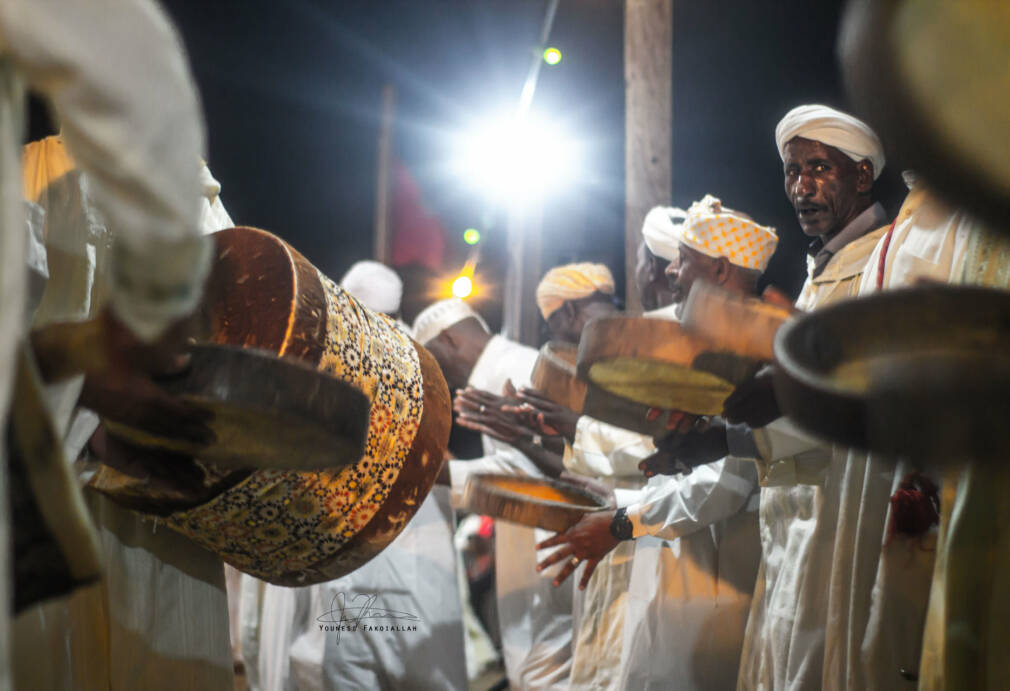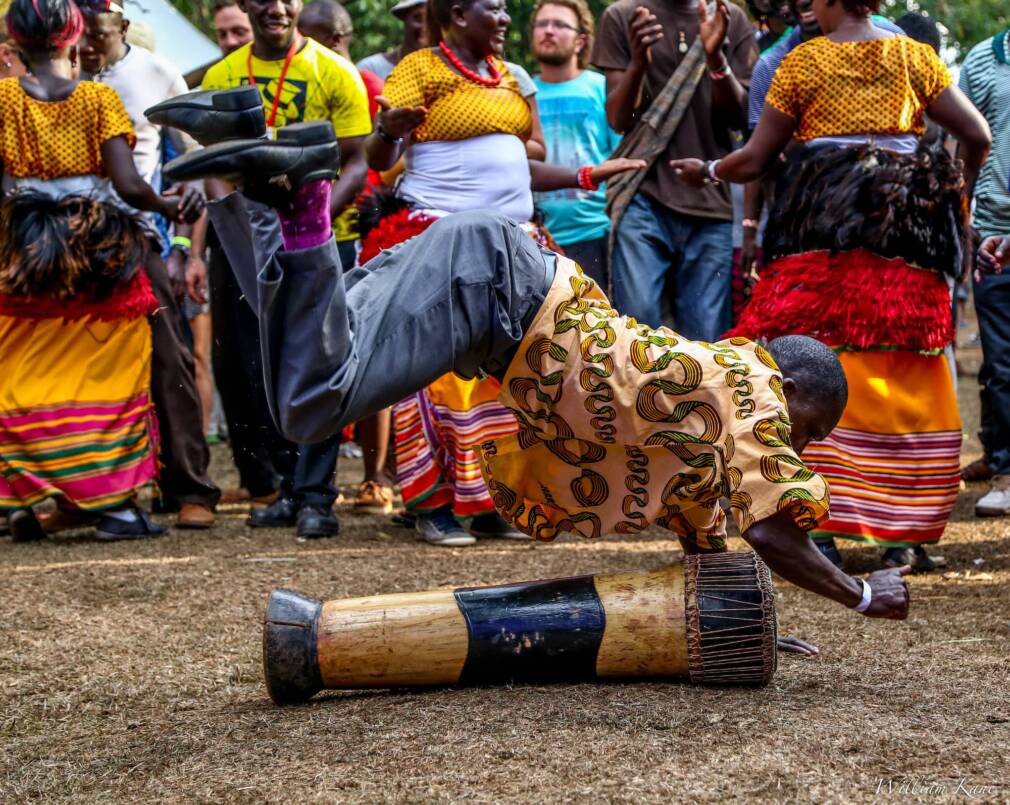How to do justice to the diversity of drums woven into the fabric of daily life in Africa? From Cairo to Cotonou, Conakry to Kampala, drums are a vessel of intangible cultural heritage, communicating, entertaining, and healing, speaking many languages with an emotional immediacy we understand in a heartbeat. Here we attempt an audit of African drums by meeting a few and better understanding their cultural context whilst paying homage to some of their notable players.
The Djembe
Perhaps the most ubiquitous of all African drums, the djembe is a goblet shaped drum constructed from West African hard wood and mounted with a goat skin head. Dating back at least a millenia to the pre-colonial Mali empire which traversed modern day Guinea, Mali, Burkina Faso, Ivory Coast, Gambia and Senegal, the name comes from the Bamanakan (a lingua franca across the West African Sahel) saying “Anke djé, anke bé” meaning everyone gather in peace neatly summarising a variety of communal occasions that call for the djembe.
The djembe does not work alone though, and as we will see in this survey most drums have siblings. The djembe family consists of three counter pitched drums all mounted with calf skin which, in ascending pitch are the dundunba, sangban, and the kenkeni. Played with one stick the player uses to strike the head and another stick used to play a melody on an iron bell attached to the barrel of the drum (lest we forget these drums originate with the blacksmith) these three drums are collectively known as dunun and accompany djembe playing in the folkloric setting.
This orchestration of djembe music was first experienced internationally thanks to the national ballets created across West Africa as part of the authenticity policies created around independence. In Guinea for example, Fodéba Keïta created Les Ballets Africains to showcase and celebrate dance and music from the country’s various ethnic groups. Also responsible for disseminating djembe culture around the world was Mamady Keïta whose commitment to the pedagogy of the djembe has planted the instrument around the world. Indeed, today the djembe has become a truly pan-African drum and almost talismanic for the continent, present in many genres within the diaspora.
The Tama
Talking drums can be found across Africa notably with the Yoruba in Nigeria and Dagomba of Ghana, but let us concentrate our attention on the Senegalese Tama. The tama is an hourglass shaped double headed drum with a taut playing surface of reptile (usually lizard) skin tensioned by rope. Held under the arm and beaten with a curved stick galan bi in Wolof, the player squeezes the tama to modulate the pitch thus producing a wide variety of tones and syntax. Agreed to have originated with the Serer ethnic group in Senegal and Gambia, the tama can speak proverbs, announce news, cajole, and invite people to dance. It has also become associated with the Senegalese national sport of wrestling known as Laamb in Wolof.
The tama has further been absorbed into popular music since at least the 1970s as a key ingredient in Mbalax music. Mbalax is a product of `Urban Wolofness’ wherein the culture of many Senegambian ethnic groups has been mixed to form a pan-African music that borrows from Cuban music, rock and funk. Taking its name from the accompanying rhythmic patterns played on the Sabar (a set of Senegambian drums played with one stick and one hand) mbalax was popularised by artists such as Youssou N’dour, Super Diamono, and the recently departed Thione Seck. Note how the sabar here trade long rhythmic phrases known as bak to which the dancer responds.
Said to be responsible for the creation of more than 500 new rhythms – The late Doudou N’diaye Rose is perhaps the greatest known Sabar player and the father of a musical dynasty that continues his work. If the Sabar are siblings, then the tama is a solo instrument and in mbalax a conversational drum capable of animating bystanders into dancers thanks to its unique ability to speak.
The Bendir / Duff
Distributed across the Maghreb, with or without jingles, exist various frame drums. From Egypt to Algeria, Tunisia and on to Morocco these shallow single playing side cousins of the tambourine are generally held vertically with one hand and played with the other.
In Amazigh music among the various Berber of North Africa, the Bendir is used in collective music making associated with ritual, healing and cleansing. One such occasion in Morocco is the Ahwash which involves poetry, music and dance and sees two groups form lines facing each other and playing a huge number of bendir and other frame drums. The Ahwash includes elements of Berber spirituality predating Islam and is sometimes performed at the site of a saint’s tomb. Significantly within the Berber percussion tradition both men and women play drums (drums being too often the preserve of men) and performances like the Ahwash are performed outside of their village setting as here.
With the addition of brass or other metallic jingles the Egyptian Riq is another frame drum popular in North Africa. A descendent of the Daf (a frame drum similar to the bendir and found across the Levant), the riq is smaller and played by tapping the head to produce the tone, and rocking and shaking the frame to move the tiny cymbals. Popular in Takht music ensembles where it accompanies string instruments such as the Oud and violin, the daf was featured in the music of Umm Kulthum the beloved contralto singer and national hero sometimes referred to as “Egypt’s fourth pyramid” where it was played by the great Ibrahim Afifi. These days however the riq has been somewhat usurped by the Darbuka – the alloy bodied drum found across The Middle East and comparable in ubiquity to the djembe
The Engalabi/ Ngalabi
To Uganda and the last and the tallest of the drums we shall meet. Standing over four feet tall the Engalabi is a long cylindrical drum tapering slightly at the waist and traditionally mounted with the skin of a monitor lizard which is nailed to the bowl of the drum with pegs and latterly with pins. Played either under the arm with a strap across the shoulder, or angled on the floor between the player’s legs, the engalabi is played rapidly with both hands and thanks to it’s taut skin and the small diameter of playing surface in ratio to its length, produces a sharp crack that cuts through music, particularly when used to play what would be called in djembe culture an échauffement or musical acceleration.
A lead drum, the engalabi belongs to the tradition of Buganda royal court music which features the amadinda xylophone alongside various percussion and plays an important function in both ceremonies and in theatre – as well as where the two intersect as with West African ballets which find their Ugandan equivalents. One such ceremony is the okwaabya olumbe, a ceremony to install a successor to a deceased leader or elder for which the engalabi makes an appearance. Showcasing the engalabi’s role within the pentatonic musical traditions of Ugandan folkloric music The Ndere Dance Troop use the drum in a theatrical setting in Kampala, whilst the drum has been co-opted into Ugandan pop music via the genre of Baakisimba.
A traditional dance from central Uganda, baakisimba is performed at weddings, festivals and business conferences and it’s distinctive triplet feel has been transposed onto electronic instruments or otherwise remixed as in the mash ups and Afro-futurist stylings of the Nyege Nyege Tapes collective which concludes our story of rhythm, and propels this most potent of instruments firmly into the future.





